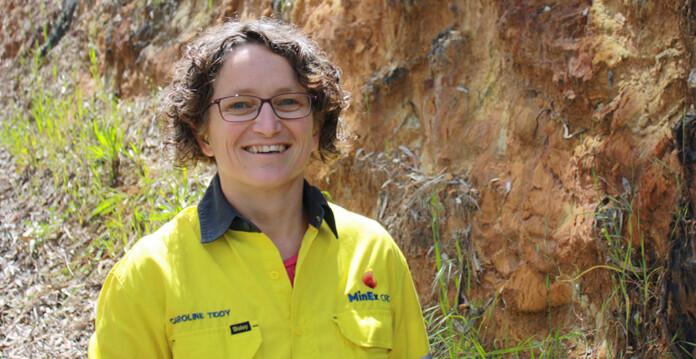University of South Australia Geoscientist Associate Professor Caroline Tiddy tells Energy Source & Distribution about finding the minerals and metals crucial to our transition to renewables.
Caroline, what interested you and made you pursue a career in geoscience?
I have always been interested in any form of science. Early on, I didn’t know what type of science I wanted to do, I just wanted to be a scientist. My first exposure to geoscience was in Year 10 high school when I did a geology course and a science program with the Museum of Victoria. I was interested, but not convinced, and going into university I wanted to be an industrial chemist like one of my high school teachers was. But then I had a spare slot in first year, filled it with Earth Science and quickly realised the subject not only fed my interest in the way the Earth works, but was also an opportunity to get outside, go on adventures and be with lots of like-minded people. I was hooked after the first field trip! Since then, the geoscience career pathway I have followed has been convoluted, with many twists and turns. Fast forward to now, and I have arrived at a place where I feel I can undertake research that moves away from being part of a problem and instead contributes to finding solutions to addressing global issues, particularly climate change.
Related article: Ancient ocean floors could help search for critical minerals
What are some of the misconceptions you face as a geoscientist working in the mining sector?
That mining is all about environmental vandalism with no respect or responsibility to the environment, the people it employs, or the communities it impacts. It makes me sad. Every geologist I know, including me, is a nature lover, has a keen interest in the sustainability of our planet, and is genuinely concerned about what we as humanity are doing to destroy our Earth through climate change. We are greenies through and through! Within Australia and several other countries, not only is the mining industry required to adhere to strict requirements around processes of metal extraction and remediation (for example), but the people in the industry want to ensure mining is undertaken in a responsible manner. ESG (Environment, Society, Governance) is a priority concern. Furthermore, there is a public disconnect between building technologies for decarbonisation and reduction in emissions to positively influence climate change and where we can responsibly get the materials required to build those technologies. Such misconceptions feed the public perception of there being no purpose to mining other than to make money.
You are developing new technologies for sourcing critical minerals. Can you tell us a bit about this?
The research I undertake is centred around developing technologies that will decrease exploration risk for critical metals such as copper, thereby increasing mineral deposit discovery success rates and ensuring sustained global supply of critical metals. The first part of this research agenda is developing cutting-edge sensor technologies that will deliver real-time geochemical assay within the challenging environment of a drill hole. The impact of this research will be in enabling rapid data interpretation and real-time decision making to assist in planning for ongoing drilling campaigns, therefore increasing the chances of a drill hole successfully intersecting a mineralised system. The second part of my research agenda involves development of geochemical targeting tools that aim to increase knowledge of mineral deposit fertility and prospectivity in underexplored regions of Australia. These projects are being undertaken as part of two research teams under the auspices of the Mineral Exploration Cooperative Research Centre, which is the world’s largest collaborative research effort into mineral exploration and brings together industry, government, and research organisations across Australia and internationally.
What are some of the major challenges facing our critical minerals and metals sector in Australia at the moment?
One might expect an answer around challenges related to finding ore deposits, the extraction of metals or mineral processing in answer to this question, but to me the biggest challenges facing the minerals sector go beyond the commodities. Instead, I think the minerals sector faces a massive challenge with public trust, which has a lot to do with image. This negative image is not only fuelled by misconceptions of environmental vandalism mentioned earlier, but is also related to issues of equality, diversity, and inclusion (EDI). Bad things have and are happening, and the media loves to report the bad news. The recent reports of sexual harassment on mine sites coming out of Western Australia are a disturbing example. The minerals sector, and more broadly, geosciences, does not have a strong reputation of being welcoming of diversity. However, I believe there is increasing awareness around equality and diversity within the geosciences and how that impacts on inclusion, and this awareness is coupled with an increasingly concerted effort to address those issues from all sectors of industry, government, and academia. There is a long, hard road to travel to build public trust within geosciences, but if we can succeed, it will turn the tide on many challenges facing the industry.
Related article: Tesla to buy over $1 billion in Australian battery minerals a year
Which minerals/metals are the most crucial to our energy transition, and how can Australia best capitalise on this growing global demand?
The transition to clean energy and decarbonisation requires numerous minerals and metals, including those that have now been categorised as ‘critical’. Australia is fortunate in that we are well endowed with many critical metals, and for some we even have some of the world’s largest or near largest supplies (e.g., Ni, Ta, Li, Cu). Industries that use critical minerals are increasingly questioning where their metal supplies are sourced and are refusing supply from countries or areas that do not practice responsible mining. Given Australia is a geopolitically stable country with high standards around environmental, social, and governance (ESG) practices, we are in the box seat to capitalise on the growing demand of the critical metals this country is rich in. High-level government support towards maximising our potential to supply such metals is pertinent to taking advantage of this opportunity. Support could include assisting miners to mine waste materials for and/or produce critical metals that are a by-product of their main commodities or to establish metal recycling practices. Such changes may be facilitated through development of current onsite mine infrastructure or backing research and development programs and policies in increasing capability of critical metal production.







